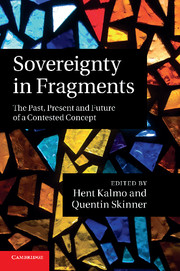Book contents
- Frontmatter
- Contents
- Notes on contributors
- Acknowledgements
- Introduction: a concept in fragments
- 1 The sovereign state: a genealogy
- 2 The apparition of sovereignty
- 3 The Westphalian myth and the idea of external sovereignty
- 4 Double binds: sovereignty and the just war tradition
- 5 The durability of organized hypocrisy
- 6 A matter of fact? The many faces of sovereignty
- 7 The survival of sovereignty
- 8 Sovereignty and after
- 9 Prolegomena to the post-sovereign Rechtsstaat
- 10 Sovereignty beyond the state
- 11 Sovereignty between government, exception and governance
- 12 Conclusion: vocabularies of sovereignty – powers of a paradox
- Bibliography
- Index
1 - The sovereign state: a genealogy
Published online by Cambridge University Press: 04 February 2011
- Frontmatter
- Contents
- Notes on contributors
- Acknowledgements
- Introduction: a concept in fragments
- 1 The sovereign state: a genealogy
- 2 The apparition of sovereignty
- 3 The Westphalian myth and the idea of external sovereignty
- 4 Double binds: sovereignty and the just war tradition
- 5 The durability of organized hypocrisy
- 6 A matter of fact? The many faces of sovereignty
- 7 The survival of sovereignty
- 8 Sovereignty and after
- 9 Prolegomena to the post-sovereign Rechtsstaat
- 10 Sovereignty beyond the state
- 11 Sovereignty between government, exception and governance
- 12 Conclusion: vocabularies of sovereignty – powers of a paradox
- Bibliography
- Index
Summary
When we trace the genealogy of a concept, we uncover the different ways in which it may have been used in earlier times. We thereby equip ourselves with a means of reflecting critically on how it is currently understood. With these considerations in mind, I attempt in what follows to sketch a genealogy of the modern state. Before embarking on this project, however, I need to make two cautionary remarks about the limitations of its scope. I assume in the first place that the only method by which we can hope confidently to identify the views of specific writers about the concept of the state will be to examine the precise circumstances in which they invoke and discuss the term state. I consequently focus as much as possible on how this particular word came to figure in successive debates about the nature of public power. The other limitation I need to signal is that I confine myself exclusively to anglophone traditions of thought. I do so in part because I need to bring my historical materials under some kind of control, but mainly because it seems to me that any study of the changing vocabularies in which moral or political concepts are formulated can only be fruitfully pursued by examining the histories of individual linguistic communities. To attempt a broader analysis would be to assume that such terms as lo stato, l'État and Der Staat express the same concept as the term state, and this would be to presuppose what would have to be shown.
- Type
- Chapter
- Information
- Sovereignty in FragmentsThe Past, Present and Future of a Contested Concept, pp. 26 - 46Publisher: Cambridge University PressPrint publication year: 2010
- 35
- Cited by



